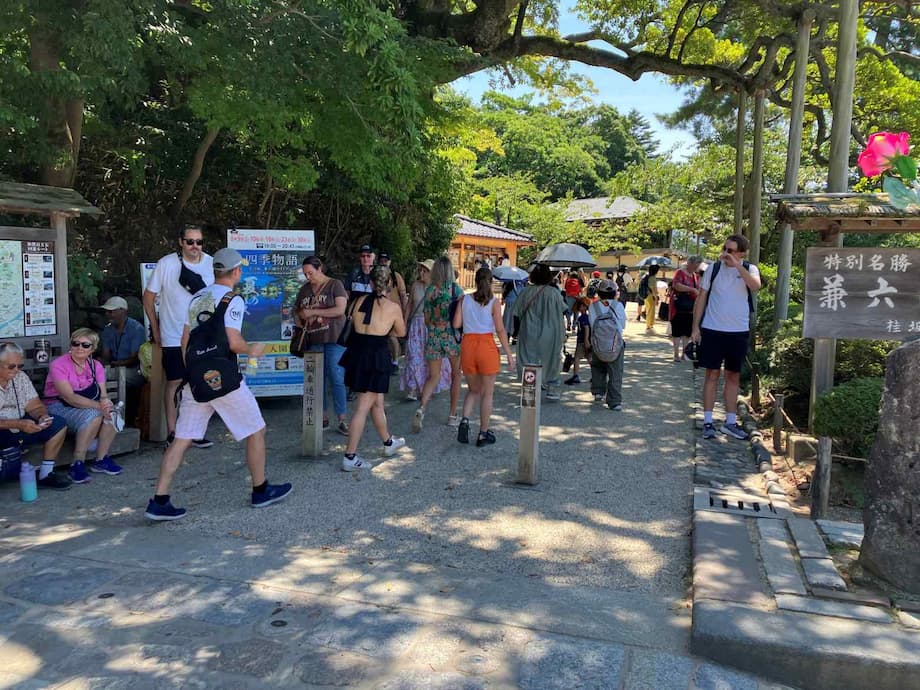A city that defies national trends
Japan is in the middle of a powerful inbound boom. More flights from nearby China and South Korea, a weak yen that makes hotels and meals feel affordable, and pent up demand for long haul travel have pushed monthly visitor tallies to fresh records in 2025. Across the country, travelers from East Asia account for roughly two thirds of arrivals, a share that shows up clearly in the busiest districts of Tokyo, Osaka, and Kyoto. Kanazawa, a compact city on the Sea of Japan in Ishikawa Prefecture, tells a different story.
- A city that defies national trends
- What makes Kanazawa click with Western travelers
- Access has improved, and it matters
- Food, seasons, and a calmer pace
- After the Noto earthquake, travel with purpose
- How the city is courting Europe and North America
- Challenges ahead, capacity and community balance
- Key Points
Tourism counts compiled by Ishikawa Prefecture show that in the first eight months of 2024, non Japanese guests at larger lodgings in the prefecture already exceeded the full year total for 2023. About half of those guests came from Western countries, including Europe and North America. That mix is the reverse of the national pattern and it is striking on the ground. In the Higashi Chaya teahouse quarter, along the earthen walls of the samurai district in Nagamachi, and around the ponds of Kenrokuen garden, the conversations you hear lean English, French, Italian, and Spanish.
Kanazawa has also been praised by international travel editors for delivering a sense of classic Japan without the stress that now comes with the busiest sites in Kyoto. The city government has pushed hard in Western markets, from trade shows to familiarization trips for travel planners. That focus aligns with the kinds of experiences the city excels at, hands on encounters with artisans, strong food culture, and a balance of history and contemporary art that appeals to travelers who plan longer stays and look for depth.
What makes Kanazawa click with Western travelers
Several features set Kanazawa apart for visitors from Europe and North America. The historic core survived the Second World War, so whole neighborhoods retain the look and feel of the Edo period. The city is walkable, public transport is simple, and the setting between mountains and the Sea of Japan gives it a different atmosphere from the Pacific side. For travelers who love Kyoto but want calmer streets and smaller crowds, Kanazawa feels like a ready answer.
Heritage without the crush
Kenrokuen ranks among the three most celebrated gardens in Japan, yet it remains easy to enjoy at your own pace, especially outside cherry blossom peak. Kanazawa Castle next door has meticulously rebuilt structures that give context to the region’s feudal history. The samurai quarter of Nagamachi offers preserved residences, stone lanes, and small gardens that hint at daily life centuries ago. Across the river, the Higashi Chaya district, with rows of wooden teahouses, still hosts traditional performances and tea experiences. The scale is human, the lines are short, and the rhythm is unhurried, which is a big draw for travelers who do not want to fight for space.
Hands on craft encounters
Kanazawa produces nearly all of Japan’s traditional gold leaf. Workshops welcome visitors to watch artisans transform wafer thin sheets into gilded tableware or to decorate trays and chopsticks. The city promotes direct contact with craftspeople through small group studio visits and demonstrations. Many visitors seek out lacquer, ceramics, and textile studios, and they often leave with pieces that feel personal and connected to the maker. The idea is simple, spend time with the people who keep these traditions alive and come away with skills and stories that last.
A living city, not a theme park
Culture in Kanazawa is not locked in the past. The 21st Century Museum of Contemporary Art brings international shows to a circular white building near the castle, and galleries scattered around town give local artists a platform. The food scene links everyday markets with fine dining, which makes it easy to fill a day with texture, from a morning stroll past tuna auctions at Omicho Market to an evening kaiseki dinner that highlights local vegetables and seafood. The combination of living culture and preserved heritage makes the city feel authentic without feeling staged.
Access has improved, and it matters
Convenience helps. Kanazawa sits two and a half hours from Tokyo by Hokuriku Shinkansen, a journey that is simple for first time visitors to Japan. In March 2024, an extension opened from Kanazawa south to Tsuruga in Fukui, stitching more of the Sea of Japan coast to the bullet train network. That upgrade has made it easier to build regional trips that link Kanazawa with temples, hot springs, and rugged coastline without a rental car.
Fukui officials say visitor traffic rose in the months after the extension, a sign that the railway is changing travel habits in the Hokuriku region. The benefit for Kanazawa is clear. The city becomes both a base and a gateway, a place to spend two or three nights while setting out for day trips to Awara Onsen, Maruoka Castle, or the basalt cliffs of Tojinbo. The flow in the other direction also helps, travelers who target Fukui or the Echizen craft towns often add Kanazawa to round out a cultural circuit.
The governor of Fukui Prefecture, Tatsuji Sugimoto, underlined the impact of the rail upgrade during a news conference in January. He framed the new service as a catalyst for the wider region rather than a one city gain.
“It is a big step forward,” Sugimoto said. He added that connecting Hokuriku with the Kanto region through the extension provides a fresh push for visitor growth.
That step gives Western travelers more reasons to cross the mountains from Tokyo. It also encourages repeat visitors to push beyond the golden triangle of Tokyo, Kyoto, and Osaka, and to spend more time on the Sea of Japan side where the rhythm of travel is slower.
Food, seasons, and a calmer pace
For many Western travelers, food is a decisive factor, and Kanazawa delivers. The Sea of Japan supplies prized fish such as yellowtail and blackthroat seaperch, and winter crabs are a seasonal star. Omicho Market anchors the scene with fishmongers, produce stands, and counter shops serving sashimi bowls. The city runs reminders that eating while walking is discouraged, especially inside the market. Most visitors embrace the local habit, find a seat, enjoy, then move on.
Seasonality frames travel choices here. Plum blossoms, then cherry blossoms, announce spring from mid March into early April. Summer brings festivals and garden shade, with the Hyakumangoku Festival on the first weekend of June filling streets with processions that recall the arrival of a powerful feudal lord. Autumn colors arrive early in Hokuriku and often linger from late September into November. Winter can be snowy, which gives Kenrokuen a different kind of beauty under yukitsuri, the rope supports that protect pines from heavy snow.
Kanazawa is also easy on the nerves. The city is flat and walkable. Buses loop the core sights, taxis are plentiful, and local guides are used to helping English speakers. Prices for lodging and meals tend to be lower than in central Tokyo, and availability is better during peak weekends than in Kyoto. Many visitors start with two or three nights, then adjust once they see how easy it is to fill days without rushing.
After the Noto earthquake, travel with purpose
The New Year’s Day 2024 earthquake on the Noto Peninsula damaged towns across the northern half of Ishikawa. Craftspeople in Wajima, famous for Wajima lacquerware, lost workshops, tools, and inventory. Kanazawa, as the prefectural capital, became a hub for support and a staging ground for events that keep traditional crafts in the public eye while recovery continues.
Visitors who care about responsible travel have leaned into that effort. Buying directly from makers, taking part in hands on workshops, and joining special studio visits that send proceeds to craftspeople are concrete ways to help. City backed programs make it easier to find those experiences and to understand the human stories behind them. The result is travel that feels meaningful and rooted in place.
How the city is courting Europe and North America
Kanazawa’s tourism team has invested in outreach beyond East Asia. Officials have spent time at travel fairs in Europe and North America, invited tour planners and media to experience the city, and focused sales efforts on culture oriented travelers, including the luxury segment. The goal is not volume for its own sake. The goal is longer stays, museum visits, studio time with artisans, fine dining, and guided tours that spread revenue across the city rather than concentrate it at a handful of spots.
On the ground, small steps make a difference. Wayfinding and museum signage are available in English. Major sites offer audio guides and printed materials that explain history without jargon. Hotels and ryokan have leaned into concierge services for foreign guests. The result is a city that feels well prepared for first timers while still offering depth for seasoned Japan travelers.
Challenges ahead, capacity and community balance
Success brings choices. Kanazawa wants to grow inbound numbers without repeating the problems seen in parts of Kyoto. That means careful crowd management at popular sites, good communication about etiquette in historic districts, and planning for how many visitors sensitive experiences, such as tea performances or small craft workshops, can host at once. It also means protecting the character of neighborhoods as more guesthouses and short term rentals enter the market.
There is also a question of balance across source markets. East Asian visitors remain vital to Japan’s economy, and a healthy mix of travelers spreads risk if currency swings or flight schedules shift in one region. Kanazawa’s unique pull with Western guests gives it a cushion, but it still depends on the national rail network, air links through Tokyo, and broader economic conditions. Keeping the experience high quality for everyone is the surest way to sustain growth.
Key Points
- Kanazawa stands out in Japan as a city where Western visitors make up about half of non Japanese guests, the reverse of the national pattern dominated by East Asia.
- Ishikawa Prefecture recorded a sharp rise in international stays in 2024, surpassing the previous year’s total by late summer.
- Kenrokuen, preserved samurai and teahouse districts, and the 21st Century Museum give a blend of heritage and contemporary culture that appeals to Western travelers.
- Hands on craft experiences, including gold leaf and lacquer, are central to the city’s draw and have taken on new meaning after the 2024 Noto earthquake.
- The Hokuriku Shinkansen puts Kanazawa two and a half hours from Tokyo, and the 2024 extension to Tsuruga makes regional circuits into Fukui and Kaga easier.
- Food is a highlight, with Sea of Japan seafood and a strong market culture, and etiquette such as not eating while walking is clearly communicated.
- City outreach in Europe and North America targets longer stays and higher local spending rather than simple head counts.
- Managing crowding, protecting neighborhoods, and keeping a good mix of source markets remain the core challenges as inbound numbers climb.




